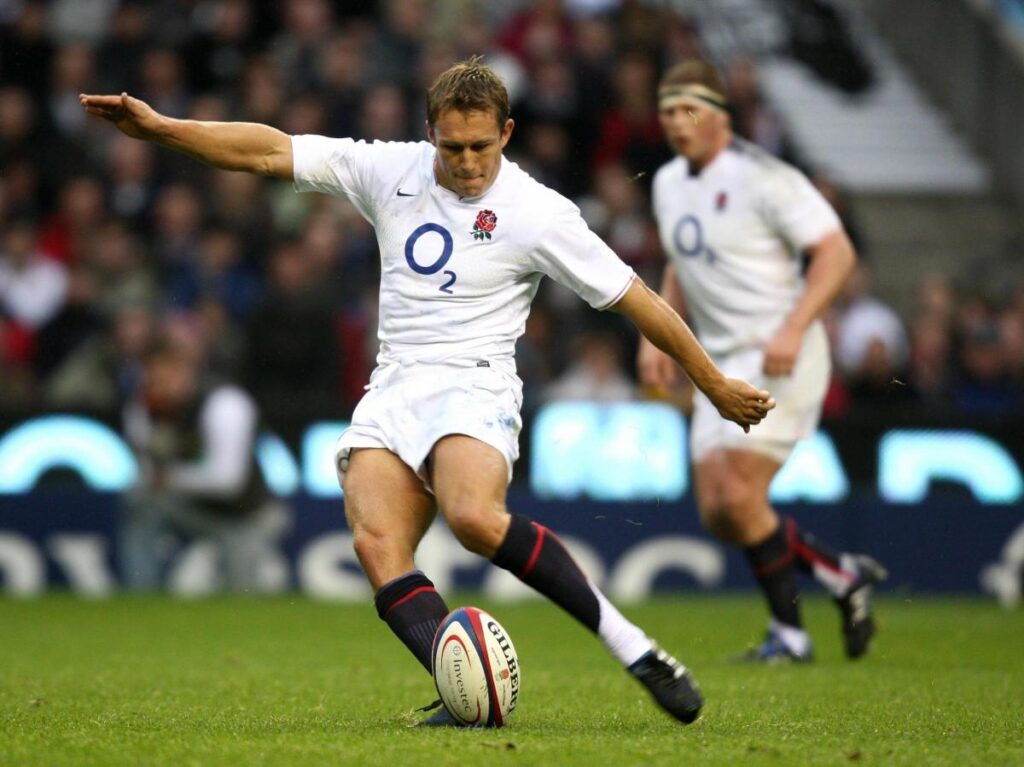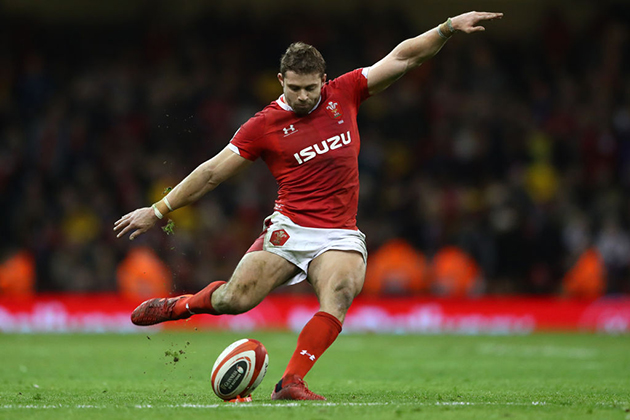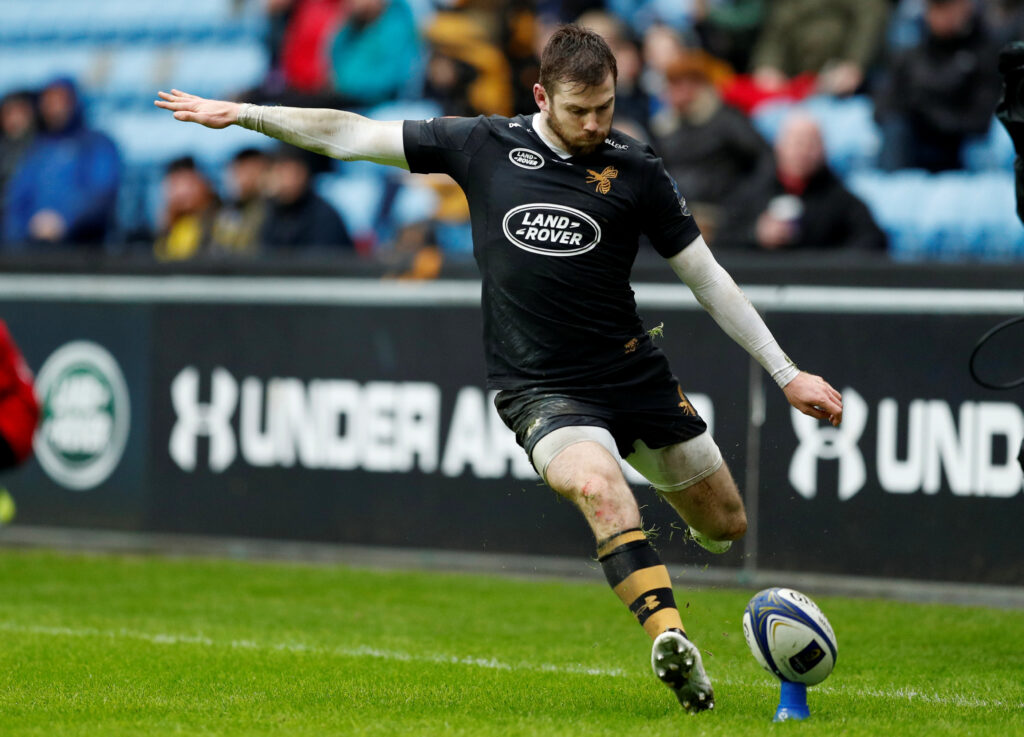
APFA
December 20, 2022
My Best Work: Sam Jones
The “My Best Work” series will give analysts, and those working in connected areas, an opportunity to showcase their best work. Our guest today is Sam Jones (@SJBiomech). Sam recently passed his masters viva from Swansea University in February, specialising in the mechanics of kicking. You will be able to find Sam’s research here in future.
“Sport has always been the primary passion of mine. I’ve played football, golf, badminton, cricket, tennis, and tried just about everything else going through my school years. However, rugby has always been the firm favourite. I started up at my local club when I was five off the back of Jonny Wilkinson’s infamous 2003 drop goal before there was even an age group for kids of that age.
Jonny Wilkinson and his on tee ball location.
Throughout my school years my love of sport continued with PE lessons always being a winner. However, it was soon quite apparent that maths was the core subject for me. I always hated writing (and secretly still do, although not quite to the same degree) but give me some numbers or a problem to solve and I was content. This continued for the duration of my education and is still very much true to this day.
Then came the big decision at the end of school – university or not to university? For one reason or another I wasn’t sure what I wanted my next steps to be. I looked around at university courses online knowing only that I ideally wanted to be on the coast. This resulted in me going on a Mechanical Engineering open day at Swansea University. I wasn’t sat in the introduction lecture long before realising this wasn’t for me. Back to the drawing board it was.
After some more online browsing I stumbled upon a Mathematics and Sports Science degree. Whilst it may sound like a very odd concoction of subject areas, one uni offering the course was Swansea. I instantly knew deep down that this was my calling. Sun, sea, sand and surfing (although it turns out not so much sun), plus it didn’t require a dissertation – win win.
The course didn’t involve any direct crossover between the two subject areas. It was generally either calculus and algebra or physiology and nutrition. However, the one area that did combine maths and sport the most was the biomechanics modules. And this is where I found most of my enjoyment and interests wandering to. Some background investigation into one of my lecturers revealed that a specialist research area of his was rugby union place kicking, and I thought it was super cool that this field of research was even a thing.
By the end of my undergrad I realised I wanted to take my interest in biomechanics further and was leaning towards a masters. I wanted to develop research skills and challenge myself, and even thought that it might be time that I try some writing. Knowing that there was a lecturer who specialised in place kicking and being a fly half myself, naturally, I decided that I would do an MSc by research focused on place kicking (something I am just finishing up currently). Now all I had to do was decide on some more precise research questions. A bit of background reading and personal interest lead me down the route of ball orientation on the kicking tee. It turned out this was something that had not been directly investigated before in rugby, yet there were multiple research papers from Australian football in particular that had used both humans and a cool mechanical kicking leg to look at ball orientation, impact locations on the foot, and resulting ball flight characteristics like velocity and spin. My research naturally changed focus slightly during my MSc, but it was mostly focused around the influence of ball orientation on technique just before foot-ball impact, and impact and flight characteristics. The final thesis title was “Investigating the Influence of Ball Orientation on the Foot–Ball Interaction in Rugby Union Place Kicking”. And that is how I’ve gotten to where I am today.

Now it’s about time to dive into some of the interesting stuff – the analysis. The first chapter of my thesis required me to watch every game of the RWC 19. Tough life I know, but it was for a good reason. I was looking at the ball orientation used for each place kick and then aiming to determine if there was some sort of association with ball orientation and success.
After collecting information on all 416 place kicks, I used this data to build a binomial logistic regression model. The output of this model then enables you to predict the percentage of success for a given kick based on the variables included in the model. Although for my MSc this model was created and used with a focus around ball orientation, it has wider implications and many potential applications. For example, it allows you to predict the percentage of success from any location on the pitch. Doing so could help to inform players and coaches on decisions from a penalty i.e. whether to kick for the posts/3 points or instead go for a try.
Much like the xG stat that has grown hugely in football in recent years, a binomial logistic regression model also allows you to measure your own xP (expected points) for rugby place kicking. The xP/predicted success is based on the ‘average’ kicker that the model was trained on. Therefore, this can be used to compare a kicker’s performance with that of the ‘average’ kicker whilst accounting for the kick difficulty (based on the variables included in the model, primarily location on the field).
Let’s look at an example. For a given kick (in this instance a conversion worth 2 points) it is calculated using the logistic regression model that the predicted success percentage is 75%; that is to say for an ‘average’ kicker that the model was trained on they have a 75% chance of scoring. Theoretically, for this conversion the ‘average’ kicker would score 75% x 2 = 1.5 points. Now if our current kicker scores the conversion then they have obviously scored 2 points. Therefore, they have gained 2 – 1.5 = 0.5 points compared to the ‘average’ kicker. However, if our current kicker misses the kick then clearly they have score 0 points, and so they have gained 0 – 1.5 = -1.5 points compared to the ‘average’ kicker (actually lost points in comparison). Overall, this points gained metric can therefore be used to assess and compare the performance of kickers whilst also taking into account the difficulty of the kicks they have taken.
Whilst the first study of my MSc was a sort of performance analysis-based pilot study, my research was mostly biomechanical and this is where my main experimental study comes in. As briefly mentioned previously, I wanted to explore the influence of ball orientation on various kinematic variables around the impact phase of place kicking. To do this my main variables of interest included: the swing plane of the kicking foot during the downswing, the orientation of the shank and foot at initial foot-ball contact, impact location on the ball, the plantar flexion motion of the foot during impact, impact efficiency and the subsequent flight characteristics of the ball.
A handful of rugby kickers and soccer kickers (included since they don’t already have a preference for a particular ball orientation) each took several kicks with a variety of ball orientations. Although the nature of the research was very exploratory and the small sample size means that not many concrete conclusions could be made, it was clear that changing the ball orientation resulted in changes to the impact location on the ball. And this will likely come as no real surprise given the ovoid shape of a rugby ball. When the ball was placed with a flatter, more horizontal orientation the impact location was near to the point of the ball and when it was placed more upright the impact location was nearer the belly of the ball. Despite this, it appeared to be the case that changing ball orientation generally had only small effects on variables relating to technique before the impact phase. It did seem though that ball orientation had slightly larger effects on the efficiency of the impact.
Leaning the ball backwards on the kicking tee is something that is often associated with novices and is rarely, if ever, seen within elite kickers. In fact, ‘specialist long distance kickers’ such as Elliot Daly generally appear to place the ball more horizontally and so impact near the point of the ball. However, my research may indicate that leaning the ball backwards and impacting nearer the belly is actually beneficial for impact efficiency (a finding consistent with previous research), and so for a given foot velocity it would improve the resulting ball flight velocity. Consequently, this would likely translate to the ability to kick over longer distances and improve the point scoring opportunities for teams. All this could be done seemingly without large consequences on the kicker’s technique. Therefore, it may be warranted that exploration of a more backwards ball orientation that leads to an impact location nearer the belly of the ball would be valuable for both kickers and coaches. Nonetheless, there are still plenty of unknowns and room for research into place kicking and ball orientation in particular.

Kicking in general appears to be a growing interest in rugby with kicking from hand being a very controversial area of the game at the moment. However, I believe it gets more flak than it deserves and I think that data actually supports a strong kicking game. Regardless of what you think on this matter though, there is no arguing that data usage is growing in all sports and will increasingly drive decision making and performance moving forward.”
If you would like to contribute to this ongoing series and feel you have an interesting story to tell, please email me at sam.rhys.larner@gmail.com.
